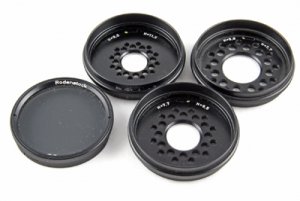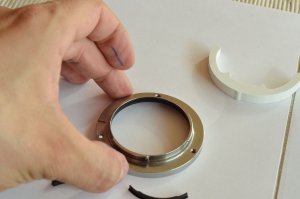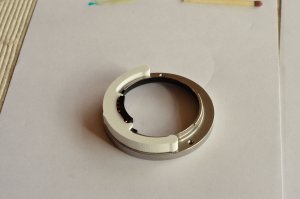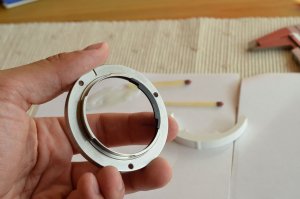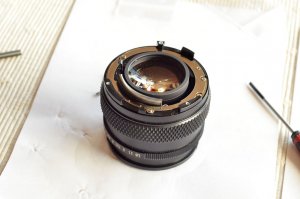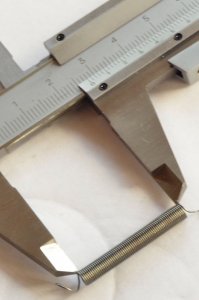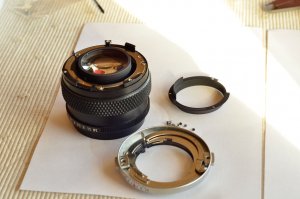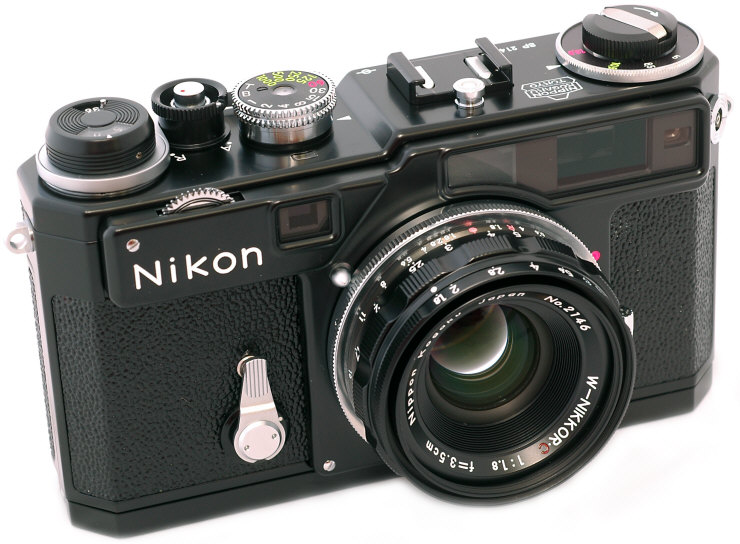Nytt speilrefleks.
- Trådstarter mutz
- Startdato
Diskusjonstråd Se tråd i gallerivisning
-
Yess, mente fatning. Bestilte Dandelion også.coolbiz skrev:
Jeg har også et slikt objektiv liggende, så det hadde vært fint om du deler dine erfaringer med konverteringen. Bestilte du Dandelion-chip også?mutz skrev:<...>
Når det gjelder manuellobjektiver er jeg imponert over Zuiko OM 50mm F1,4. Har bestillt en overgang til F-mount tenkt til dette objektivet.
<...>
Regner forresten med at det ikke er overgang du mener, men en ny fatning.
Skal poste erfaringene med denne løsningen så snart jeg får de. Kan slenge inn noen sammenligningsbilder med Nikon 50mm F1,8. Det kan bli spennende.
Jeg skal gjøre et forsøk uten splittprisme først så vil det fort vise seg om det ikke fungerer.Bach_Man skrev:Det går jo også an å bytte mattskive til en med splittprisme for manuell fokusering, synes det grenser til masochisme å fokusere manuelt uten i bevegelige situasjoner selv med fokusindikator.
Det jeg er litt bekymret for ved bytte til splittprisme er hvordan lysmåling mm. lar seg påvirke. Spesielt spottmåling siden man da måler rett i "splitten" :Gratulerer til Nikon, det er et fantastisk kamera, spesielt når man får satt det opp etter egne behov. Faktisk finnes det for øyeblikket ikke noe annet kamera i Nikon sin lineup som treffer sweetspoten mellom funksjonalitet, vekt og byggekvalitet bedre. Er etter sigende mange proffer som bruker den som backup. Hvis de hadde laget et FX-kamera av samme dimensjoner hadde jo det vært noe å sikle etter, men mesteparten av FX-optikken spiser jo opp en evt. vektfordel.
Nå ryktes det jo at Nikon kommer med en profflansering denne måneden, oppfølgere til D3 og D700 skal være på trappene. Jeg er spent, det blir vel utvilsomt de beste 35mm DSLRene hittil, og forhåpentligvis får vi endelig et svar på 5D MkII.Må innrømme at jeg var svært nær ved å kjøpe Canon EOS 7D. Og tror nok jeg kunne levd lykkelig med dette kameraet også.
Det senker nevrosene en smule å få slike bekreftelser på at valget var korrekt, meeen må innrømme at jo mer jeg leser, jo mer lyst får jeg på fullframe.........Hva er det egentlig full frame kan gi deg som D7000 mangler? Ultravidvinkelobjektiver er vel den viktigste forskjellen. Ellers får jeg bare anta at du liker å drasse rundt på 3-4 kg utstyr. Enorme D3 veier vel omtrent dobbelt så mye som D7000, D700 veier ca 1.2 kg.Vel, siden du spør
Det plager meg en smule at DX objektivene ikke fungerer på fullframe. Om jeg på et senere tidspunkt skulle ønske å gå den veien sitter jeg med objektiver som må byttes ut. Klart jeg kan kjøpe FX objektivene til D7000, men det blir perler for svin som Gunnar Brekke påpekte. En senere oppgradering til fullframe blir derfor unødvendig dyrt sammenlignet med den relativt moderate ekstrakostnaden om jeg hadde hoppet over mellomleddet i dag. D700 og et egnet objektiv hadde blitt ca 10000 dyrere.
Det andre momentet er mindre støy på høy iso, noe som var en viktig årsak til oppgraderingen i utgangspunktet.
Uansett, nå skal jeg ta masse bilder med kameraet jeg har kjøpt. D7000 er mer enn godt nok til mitt bruk pr. nå. Trolig møter jeg meg selv på halvveien og kjøper FX optikk slik at skrittet blir mindre i tilfelle jeg bytter ut mørbrad med filet mignon på sikt.Ikke noen grunn til å bare kjøpe DX-objektiver, FX-optikk er ikke perler for svin. D7000 har den høyeste pikseltettheten av alle Nikons kameraer, inkludert D3x, så den stiller strenge krav til kvaliteten i optikken (neste DX-kamera ut blir antagelig 24Mp, hvordan skal det gå?). Dessuten vil FX-optikk med sin større bildesirkel vignettere mindre på et DX-hus enn DX-optikk. For normal/vidvinkelzoom ville jeg satset på DX, store 2.8-zoomer blir for fortungt og dyrt på et lite DX-kamera. Og riktignok synes jeg at 14-24 f/2.8 er knalltøff, men den er jo ikke så vid som den skal være på DX. Det finnes masse fullframe-fastopptikk av moderat størrelse som kan egne seg godt til et DX-kamera, og D7000 har jo fokusmotor i huset. Jeg nevner i fleng: 20mm f/2.8 AF-D, 24mm f/2.8 AF-D, 50mm f/1.4 AF-S og 85mm f/1.8 AF-D.- Ble medlem
- 18.02.2009
- Innlegg
- 24.485
- Antall liker
- 15.017
- Sted
- Kopervik og Bergen
- Torget vurderinger
- 1
Først av alt: Canons f/1,2 er knapt verdt å nevne, for den er langfra på høyde med Nikkors tilsvarende med manuell fokus. Og skal det brukes så store blendere så må man uansett bruke manuell fokus. Den som er verdt å nevne er Canons f/1,0!Bach_Man skrev:Historisk sett har nok lysterk optikk blitt utviklet for å få nok lys på filmen, men i dag er det mer snakk om 'bragging rights'. Objektiver som Canons f/1.2 eller (gisp!) Leica Noctilux f/0.95 har vel strengt tatt liten praktisk anvendelse og relativt sett enorme dimensjoner. Tar man et portrett på en slik blenderåpning er øynene i fokus og nesetippen ikke. Hvis man får noe i fokus i det hele tatt da. Erfarne proffer kan ha bruk for noe slik, men sjelden hobbyfotografer. Husk også at de fleste yrkesfotografer har en relativt langsom f/2.8 zoom som arbeidshest. Det forhindrer meg ikke i å vurdere innkjøp av en Nikkor 85mm f/1.4, selv om f/1.8 er langt rimeligere, mindre og omtrent like skarp.Men den er heller ikke særlig vellykket ut fra objektive kriterier, men skal visstnok ha en sær kvalitet som enkelte liker. Det samme gjelder i og for seg Leicas psyko-objektiv. Vi må vel heller ikke glemme Zeiss astro-objektiv som ble konvertert til 35mm kinofilm for Kubric da han skulle skyte en scene i lyset fra et stearinlys under innspillingen av Barry Lyndon. Det finnes visstnok de som har slike konvertert til Nikon, men skal ikke garantere at opplysningen er sann.
Som du skriver så får du ikke ører, øyne og nesetipp skarpt ved bruk av 1,2 til ansiktsportretter. Jeg brukte i årevis Nikkors 1,2 normal, men ikke til ansiktsportretter. Jeg testet det, så jeg kan skrive under på at fokusfeltet er så snevert. I tillegg er lyssterke objektiver mindre rett-tegnende, og egner seg altså dårlig til slike bilder generelt. Det jeg brukte den mest til var å gatefotografere i eksisterende lys. Da får ting litt avstand, og den ekstreme dybdeskarpheten får ikke samme dramatiske effekt. Ved infinity er det jo infinity uansett hvor liten eller stor blender du har valgt. Helfigurportretter på full blender fungerte også helt topp, for på den avstanden får man en DOF som er mer anvendelig. Det er da også den typen portretter som er vanskeligst, så med en slik krevende optikk blir det en skikkelig kreativ utfordring. Slik synes jeg er gøy!
Det stemmer i så og si alle tilfeller. Skikkelig gode objektiver har liten forskjell mellom største og neststørste blender. I noen tilfeller er det stort sett bare kantskarpheten som påvirkes i synlig grad, og det er jo perfekt for de som bruker fullframe optikk på DX/APS-C.Class skrev:
Nuvel.Bach_Man skrev:Historisk sett har nok lysterk optikk blitt utviklet for å få nok lys på filmen, men i dag er det mer snakk om 'bragging rights'.
De fleste objektiv bør stoppes ned ett trinn eller to for å yte sitt beste. Med raskt glass er det fremdeles mye lys som slippes igjennom kontra noe f/5+ greier som mister et par trinn...
I Nikons tilfelle er det liten forskjell på 50mm f/1,8 og 1,4 når det gjelder skarphet, for den billigste er utrolig god til prisen. Ved f/2,8 tror jeg de er temmelig like. De som velger Canon må ikke lulle seg inn i den tanken, for i deres tilfelle stemmer det rett og slett ikke. Canons 1,8 mkII har jeg selv, og det er årevis siden den var oppe av skuffen. MkI er faktisk litt bedre, men der er også langt fra noen 1,4 - som er en regulær perle. På mange måter et grusomt objektiv som kun velges hvis man ikke har penger til noe annet, og ikke gidder å sjekke bruktmarkedet for manuelle objektiver som kan konverteres enkelt. Dermed blir valg av stor blender også et valg av bildekvalitet sålenge det dreier seg om 50 mm. Canon har forresten fokusindikator og lysmåling på nedblending i alle husene.
Hva som er optimal blender varierer, for i tillegg kommer diffraksjonen når blenderen blir mindre. Husk at på DX-sensor inntreffer diffraksjon stort sett kjapt etter f/8. Kanskje ikke synlig ved f/11, men den er der. På min "ugly duckling" inntreffer den allerede ved f/8. Ikke definitivt synlig, men det er der det starter. Idealblenderen er faktisk f/3,5-4 på det objektivet, det vil si et trinn nedblending. På fullformat kan nok den skalaen senkes et trinn eller to mtp diffraksjonen, for den er formatavhengig.The Online Photographer hadde en artikkel i dag om portrettobjektiver som er for skarpe. Old school portrettobjektiver var mykktegnende. Og det er jo et poeng, man vil jo ikke se alle porer og imperfeksjoner, silkemyk hud er jo mer flatterende. Så hva med å droppe oppskarpingen i hvert fall, bare ha litt skarphet og kontrast på øynene? Så slipper man Rockwell-looken (han skrur johvitbalansen i tillegg til alle blir oransje i trynet).
http://theonlinephotographer.typepad.com/the_online_photographer/blog_index.html
Paolo Roversi bør visst skaffe seg et skarpere objektiv og blende ned noen hakk for optimal skarphet:Vedlegg
-
79.6 KB Visninger: 411
Til myke portretter er fortsatt mellomformat med Rodenstock Imagon uslåelig, med sine hullblendere langs periferien til å slippe inn valgfrie mengder oppmykingslys, det blir mykt uten å være uskarpt. Men det er sjelden jeg tar frem klenodiet!
-------------------------------------------------------------------------------------
Beskrivelse: In 1979 Dr. Alfons Scholz, of the G. Rodenstock Optical Works Munich published the definitive scholarly exploration on the topic of Imagons with supporting photographs. The following is a précis of his thoughts and his history of soft focus lenses:
In a nutshell, the Imagon lens is based on a 2 element Achromat. One of the simplest lenses available. Imagons have 2 unique properties. a) Tremendous depth of field due to the fact that light is not resolved at the focal plane but exhibits instead a zone of focus and b) The ability to stay gently diffused even while sharpening up at small apertures.
Invented by Dr. Heinrich Kuhne (1868-1944) and still in production by Rodenstock, these lenses represent, in the purists sense, an ideological struggle that took place amongst lens designers prior to current times. Should a lens produce the sharpest technically correct image possible or should a lens produce an image the natural way that the human eye sees light, which is directly speaking, a low resolution interpretation of reality with fuzzy edges sharpened and refined by the brain.
The simplest photographs are pin hole images, image sharpness is affected by aperture, but the length of exposure is too great for general use. Daguerre and Niepce used the simple 1 element Wollaston (1812) Meniscus Lens in their cameras. In essence an eyeglass lens with a diaphram mounted at the front. This lens caused light to converge at the film plane thereby speeding the imaging process. The Meniscus lens was useful primarily in the near shooting range such as portrait work and was restricted to small film formats. In 1897 Henry S. Smith produced a 2 element 'semi achromat' in Boston which was used by Alfred Steiglitz for 5x7 and 8x10 formats. This lens produced a shimmering quality and was initially considered difficult to work with because different shooting circumstances produced wildly divergent results and also because shorter focal length lenses proved to be too soft.
In the 1920's in Rathenow Germany, Nicola Perscheid, a renowned portrait photographer approached Emil Busch A.-G. about custom making a portrait lens. Thus the Aplanat was born.* The design was inspired by the periscope which is two meniscus lenses, concave to concave, with the addition of a divergent lens cemented in between. Like the Meniscus and Smith lenses before it, softness was variable according to aperture such that by f 8 the image becomes sharp.
After the first world war Voigtlander introduced the Universal Heliar which was produced up until 1970. This design allowed softness at all aperture settings for large format work with longer focal lengths. In the 30's Ernst Leitz introduced the 9cm Thambar f2.2 for 35mm use. This 4 element design was replaced by the Hektor 125mm f2.5 after the 2nd world war. Both lenses produced soft images wide open, sharpening up as the diaphram is closed down.
It was in the 20's that Kuhn, who was a photographer, approached Dr. Franz Staeble, a lens designer in Munich, with his concept of what a lens should be, 'romantic softness without sugariness, blurring without a woolly effect'. The first Imagon hit the market in 1928 and was called Kuhn's Anachromat. In 1930 the Staeble lens works were acquired by Rodenstock and in 1931 the Imagon was introduced.
The Imagon was available in 3 focal lengths: 200mm H5.8, 250mm H5.8 and 300mm H7.7. *
The 200mm has a covering power of 154mm and therefore can be used on 4x5 without movement, although it is primary adapted to Medium Format cameras. The 250mm has a field of 180mm and is thus a better choice for 4x5. The 300mm covers 5x7 (220mm field).
Focusing an Imagon is technically challenging and should be done at the taking diaphram due to a focus shift which occurs when closing down. The discs can then be mounted to produce the halo effect for which the Imagon received it's patent. The subject is usually lit in a contrasty fashion to counter the softness of the lens, however at H 11.5 the Imagon produces a hard shape focus with very little diffusion. The Imagon is not simply a soft focus lens, but more accurately a lens with variable image production qualities that will reward the student of photography with unique interpretations of portrait and field work limited only by the imagination.Vedlegg
-
101.9 KB Visninger: 373
Og her er selve kameraet, 6*9 på 120-filmVedlegg
-
118.6 KB Visninger: 385
Ikke ulikt denne fra LensBaby (finnes for Nikon-F):Barbaresco skrev:Til myke portretter er fortsatt mellomformat med Rodenstock Imagon uslåelig, med sine hullblendere langs periferien til å slippe inn valgfrie mengder oppmykingslys, det blir mykt uten å være uskarpt.

Ved hvilken blender diffraksjon setter inn, er ikke et spørsmål om sensorstørrelse, men om senselstørrelse.baluba skrev:Hva som er optimal blender varierer, for i tillegg kommer diffraksjonen når blenderen blir mindre. Husk at på DX-sensor inntreffer diffraksjon stort sett kjapt etter f/8. Kanskje ikke synlig ved f/11, men den er der. På min "ugly duckling" inntreffer den allerede ved f/8. Ikke definitivt synlig, men det er der det starter. Idealblenderen er faktisk f/3,5-4 på det objektivet, det vil si et trinn nedblending. På fullformat kan nok den skalaen senkes et trinn eller to mtp diffraksjonen, for den er formatavhengig.Hei.
Med portretter er vel alt lov - også PhotoShop.
mvh
Gunnar BrekkeVedlegg
-
482.7 KB Visninger: 174
Vet ikke om dette er bra, men på http://www.giveawayoftheday.com/magic-skin-filter/ får du et program gratis (kun i dag!) som kan "pynte" på portrettene dine - etter et par tastetrykk (etter hva jeg forstår). Må lastes ned/installeres og registreres i dag. Men den som kan sin PhotoShop trenger kanskje ikke dette?Gunnar_Brekke skrev:Med portretter er vel alt lov - også PhotoShop.Jeg er ikke egentlig på jakt etter nytt kamera nå, men liker tanken. Jeg har ikke fulgt godt med på Nikon sine lanseringer og oppgraderinger de siste årene, etter at jeg kjøpte min D80. Men en oppgradering er alltid aktuelt, noen av oss er bare sånn skrudd sammen i hodet. Kunne tenke meg et kamera som kan brukes helt lydløst, med live-view, mirror-up-funksjon, høyere ytelse i svakt lys, GPS, og gjerne wi-fi eller liknende.
Jeg har plukket opp ryktene om lanseringen av D400 og D800, disse bør kunne tilfredsstille kravene.
Men hvor blir de av? Det var lenge snakk om lansering nå i august.
Jeg hørte en samtale i fotobutikken her om dagen, der forhandleren sa at august kan vi bare glemme og det hele er utsatt på ubestemt tid. Sannsyligvis på grunn av jordskjelvet og tsunamien. Da tenker jeg at her kan jeg vise min støtte til japsene når disse endelig kommer. Jeg har god tro på D400, og venter i spenning.Forstår at vi er flere som venter på ny lanseringer fra NikonDet er mulig å følge med på rykter her
http://nikonrumors.com/
-sandeckerOnsdag i neste uke ryktes å være lanseringsdato for D4 og etterfølgeren til D700 (D800?). D300s får ikke avløsning (D400?) før februar 2012. Dessuten har Nikon et nytt "mirrorless" kamerasystem på trappene for å konkurrere mot Olympus' og Panasonics m4/3 og Sonys Nex, men med mindre sensor enn disse.
Vil D4 og D800 ha samme sensor? Vil D4 overta for både D3s og D3x eller vil Nikon etterhvert også lansere en D4x? Vil D400 ha samme sensor som D7000 eller den nye 24mp DX-sensoren fra Sony? Ryktene spriker i alle retninger. Noen av ryktene er dog litt mer konsekvente gjengangere: et helt nytt autofokussystem, forbedret video, høyoppløsningssensorer med binning.
Som følge av vedvarende strømforsyningsproblemer for fabrikken i Sendai ser det desverre ut til å Nikon har valgt å produsere flere av de nye modellene i fabrikken sin i Malaysia.Vi får se. D3 og D300 ble i sin tid lansert samtidig og så kom D700 nesten et år etterpå. Lenge gikk ryktene ut på at samme mønster ville gjenta seg med D4/D400 og D800, men bl.a. Thom Hogans kilder sier at det denne gang blir FX-modellene først. Årsaken kan være at D7000 selger så bra at Nikon føler mindre press på seg til å lansere en ny toppmodell i DX-rekken, og heller prioriterer D800 for å komme Canon 5DIII i forkjøpet.Fikk pakke på fredag.
Det var F-fatningen til Olympus Zuiko OM 50mm F1.4 objektivet mitt. Dette er et objektiv jeg liker veldig godt, som jeg håpet kunne la seg bruke på D7000.
Tok med meg småverktøy og godt humør på hytta i helgen.
Her er alt lagt ut klart til arbeid.
F-fatningVedlegg
-
110 KB Visninger: 134
-
140.9 KB Visninger: 142
Så til objektivet. Her er original fatning demontert.
Med i pakken fulgte en stålfjær av beste kvalitet. Denne skulle tilpasses i 25 mm lengde. Endene må bøyes på bestemt vis. Dette var ikke plankekjøring. Fjæren er responsiv for å si det slik.
Fjæren skal gjøre det mulig å regulere blendeåpningen. Uten den er det full åpning hele tiden.
Her er den på plass... en liten stund.Vedlegg
-
125.1 KB Visninger: 170
-
124.1 KB Visninger: 125
-
145.9 KB Visninger: 140
Monterte F-fatningen på objektivet. So far so good.
Tok et bilde og ante den søte duften av suksess.
Så smallt fjæren av. Fiasko!!!!
Har forsøkt å montere fjæren på nytt flere ganger. Når man regulerer blendeåpningen ved uendelig fokus spretter fjæren av. I det hele tatt virker denne fatningen nokså hjemmelaget.
Til Coolbiz... Kan ikke anbefale denne varianten. Enn så lenge gir jeg opp Zuiko på Nikon.Vedlegg
-
127.5 KB Visninger: 166
Takk for info! Dumt at det ikke virket helt som forventet. Er det helt umulig å få fjæra til å sitte, eller er det et spørsmål om verktøy? Hjelper det f.eks. å varme opp enden på fjæra før du lager krokene på den?
Din Zuiko 50mm f/1.4 ser ikke helt ut som min, forresten. Din har sort overflate på kanten helt fremst, der min er sølvfarget. Jeg tror din er nyere.
Her er forresten noe som ser ut til å gi seg ut for å være lekkasje av kommende D4 og D900 (!): http://news.xinhuanet.com/it/2011-07/26/c_121722956.htm
Skal ikke påstå det er umulig. Men jeg kan garantere at det er en utfordring.coolbiz skrev:Er det helt umulig å få fjæra til å sitte, eller er det et spørsmål om verktøy? Hjelper det f.eks. å varme opp enden på fjæra før du lager krokene på den?
Fjæren skal monteres slik at den vandrer i høydeplanet samsvarende med ekspansjonen på objektivet. Det er ikke noen "stopper" i vertikalplanet på pinnen der fjæren er festet. Objektivet ekspanderer ca 1 cm mellom fjern og nærfokus. "Festepinnen(den fjæren skal trekke i)"er 1 cm høy. Siden fjæren vandrer hele lengden til pinnen ved fjernfokus ser jeg ikke hvordan man skal kunne unngå at den spretter av når man strammer fjæren for å blende ned. Den eneste løsningen jeg ser er å lage et hakk i pinnen som stopper fjæren vertikalt.
I tillegg skraper fjæren på sylinderen ved fokusering.
På dette bildet ser du hvor fjæren er plassert på høyresiden. Her er objektivet regulert til nærfokus. Fjæren er heller ikke strukket som den blir når du blender ned.Vedlegg
-
148.9 KB Visninger: 430
http://www.techradar.com/news/photo...kon-d800-rumours-what-you-need-to-know-931110coolbiz skrev:Vi får se. D3 og D300 ble i sin tid lansert samtidig og så kom D700 nesten et år etterpå. Lenge gikk ryktene ut på at samme mønster ville gjenta seg med D4/D400 og D800, men bl.a. Thom Hogans kilder sier at det denne gang blir FX-modellene først. Årsaken kan være at D7000 selger så bra at Nikon føler mindre press på seg til å lansere en ny toppmodell i DX-rekken, og heller prioriterer D800 for å komme Canon 5DIII i forkjøpet.
-det kryr av rykter. Vi får se.
Årsaken kan være at D7000 selger så bra at Nikon føler på seg for å lansere en ny toppmodell i FX-rekken for å levere FX-modeller som kan matche D7000s overlegne kvaliteter.coolbiz skrev:...men bl.a. Thom Hogans kilder sier at det denne gang blir FX-modellene først.Nikon har jo neglisjert DX-optikk på proffnivå, så da blir jo et proft DX-hus nokså unødvendig, like greit å gå fullframe når man likevel skal lesses ned med FX-optikk. Eneste fordelen jeg kan tenke på er DX brukt som telekonverter uten lystap.Har lest meg igjennom den siste lanseringen til Sony nå. Med utviklingen innen elektroniske søkere er den feite bråkete speilrefleksen snart død, og godt er det. Sony NEX 7 har en 24mp APS-C sensor (som Nikon også sikkert kommer til å ta i bruk) og innebygget elektronisk søker i en slank kropp. Hvorfor skal et kamera trenge å være større? Sony A77 er stor som en DSLR, men har et statisk gjennomsiktig speil som lar AF-sensorene jobbe kontinuerlig ved serier på opptil 12 fps, i motsetning til hva Nikon og Canon kan tilby. Det eneste som holder Sony tilbake er et noe glissent utvalg av spesialoptikk i forhold til de to store. Spennende å se om Nikon og Canon kommer med noe radikalt ved neste lansering. Jeg dropper i hvert fall speilrefleksen så snart mirrorless er bra nok, kanskje er det ikke i denne kameragenerasjonen, men det blir nok ikke lenge til.
Jeg har store hender og vil ha noe skikkelig å holde i og knapper jeg kan betjene med hansker på.Bach_Man skrev:Hvorfor skal et kamera trenge å være større?
D80 huset jeg hadde en gang var passe stort med vertikalgrep. På D300 er det litt bedre plass til alle fingrene.
Om det går mot pekeskjerm og/eller en zillion små knapper melder jeg pass.
Ellers er det vanskelig å ikke ønske det fysiske speilet erstattet av elektronikk men jeg må nok si at for meg er det noe av sjarmen - lyden av et fint kamera.- Ble medlem
- 18.02.2009
- Innlegg
- 24.485
- Antall liker
- 15.017
- Sted
- Kopervik og Bergen
- Torget vurderinger
- 1
Det har du sikkert rett i. En gang i tiden betydde det i praksis det samme, og jeg har liksom aldri forlatt den digitale speilrefleksens barndom med min 20D. Trenger nok en oppjustering av både ordforråd og utstyr snart. Sensel, se der var det et nytt ord å lære.coolbiz skrev:
Ved hvilken blender diffraksjon setter inn, er ikke et spørsmål om sensorstørrelse, men om senselstørrelse.baluba skrev:Hva som er optimal blender varierer, for i tillegg kommer diffraksjonen når blenderen blir mindre. Husk at på DX-sensor inntreffer diffraksjon stort sett kjapt etter f/8. Kanskje ikke synlig ved f/11, men den er der. På min "ugly duckling" inntreffer den allerede ved f/8. Ikke definitivt synlig, men det er der det starter. Idealblenderen er faktisk f/3,5-4 på det objektivet, det vil si et trinn nedblending. På fullformat kan nok den skalaen senkes et trinn eller to mtp diffraksjonen, for den er formatavhengig.
Det er sannelig på tide at Nikon kommer med en utfordrer til Pen, Nex og de andre uten speil. Det har vært spekulert i om Nikon skulle komme med en digital SP eller S3/4 i mange år allerede. Det er jo de lekreste kameraene Nikon har laget, sterkt inspirert av Contax. For min del er de speilløse systemkameraene blitt gode nok, men de bør ha muligheten for ekstern optisk søker i blitzskoen. Hvis de er i DX-format vil det jo fungere greit med min gamle Zeiss revolversøker, 35=50 og 50=75.

En venn har jubileumsmodellen fra 2005. Yummi! :-*Thom Hogan påstår jo at Nikon vil bruke en mindre sensor enn M4/3, og det er jo ikke godt nytt. Jeg synes mye begynner å falle på plass med Sony Nex 7, ikke minst en innebygget søker av toppklasse som ikke stikker ut som en vorteCtein har skrevet en artikkel om diffraksjonsgrensen når sensorene når stadig høyere oppløsning. For de som ikke gidder å lese linken er konklusjonen at den ikke er noe å bry seg om. Diffraksjonen vil bli synlig fortere på en sensor med 24MP enn en med 10MP, men på sistnevnte har man jo allerede gitt slipp på oppløsningen på sensornivå.
http://theonlinephotographer.typepa...11/08/nex-7-diffraction-effects.html#comments
Er det en idè å legge en liten "perle" med epoxy i enden av "pinnen" for å hindre at fjæren spretter over, samtidig som fjæren ikke fester seg i denne?mutz skrev:Siden fjæren vandrer hele lengden til pinnen ved fjernfokus ser jeg ikke hvordan man skal kunne unngå at den spretter av når man strammer fjæren for å blende ned. Den eneste løsningen jeg ser er å lage et hakk i pinnen som stopper fjæren vertikalt.
Mvh -
Laster inn…
Diskusjonstråd Se tråd i gallerivisning
-
-
Laster inn…





